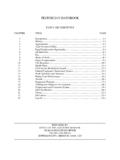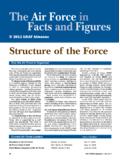Transcription of Army Support During the Hurricane Katrina OP 29 …
1 army Support During the Hurricane Katrina DisasterJames A. WombwellThe Long War SeriesOccasional Paper 29US army Combined Arms CenterCombat Studies Institute PressFort Leavenworth, KansasOP 29 Report Documentation PageForm ApprovedOMB No. 0704-0188 Public reporting burden for the collection of information is estimated to average 1 hour per response, including the time for reviewing instructions, searching existing data sources, gathering andmaintaining the data needed, and completing and reviewing the collection of information. Send comments regarding this burden estimate or any other aspect of this collection of information,including suggestions for reducing this burden, to Washington Headquarters Services, Directorate for Information Operations and Reports, 1215 Jefferson Davis Highway, Suite 1204, ArlingtonVA 22202-4302. Respondents should be aware that notwithstanding any other provision of law, no person shall be subject to a penalty for failing to comply with a collection of information if itdoes not display a currently valid OMB control number.
2 1. REPORT DATE 2009 2. REPORT TYPE 3. DATES COVERED 00-00-2009 to 00-00-2009 4. TITLE AND SUBTITLE army Support During the Hurricane Katrina Disaster 5a. CONTRACT NUMBER 5b. GRANT NUMBER 5c. PROGRAM ELEMENT NUMBER 6. AUTHOR(S) 5d. PROJECT NUMBER 5e. TASK NUMBER 5f. WORK UNIT NUMBER 7. PERFORMING ORGANIZATION NAME(S) AND ADDRESS(ES) US army Combined Arms Center,Combat Studies Institute,Fort Leavenworth,KS,66027 8. PERFORMING ORGANIZATIONREPORT NUMBER 9. SPONSORING/MONITORING AGENCY NAME(S) AND ADDRESS(ES) 10. SPONSOR/MONITOR S ACRONYM(S) 11. SPONSOR/MONITOR S REPORT NUMBER(S) 12. DISTRIBUTION/AVAILABILITY STATEMENT Approved for public release; distribution unlimited 13. SUPPLEMENTARY NOTES 14. ABSTRACT 15. SUBJECT TERMS 16. SECURITY CLASSIFICATION OF: 17. LIMITATION OF ABSTRACT Same asReport (SAR) 18. NUMBEROF PAGES 281 19a. NAME OFRESPONSIBLE PERSON a. REPORT unclassified b. ABSTRACT unclassified c.
3 THIS PAGE unclassified Standard Form 298 (Rev. 8-98) Prescribed by ANSI Std Z39-18 army Support During the Hurricane Katrina DisasterJames A. WombwellUS army Combined Arms CenterCombat Studies Institute PressFort Leavenworth, KansasOP 29 Library of Congress Cataloging-in-Publication DataWombwell, James A., 1956- army Support During the Hurricane Katrina disaster / by James A. Wombwell. p. cm. -- (Occasional paper ; 29) Includes bibliographical references. 1. Hurricane Katrina , 2005. 2. United States--Armed Forces--Civic action. 3. United States--National Guard--Civic action. 4. Disaster relief--Gulf states. I. Combat Studies Institute ( ) II. Title. III. Series. HV636 2005 .U6 W66 2009 9220976090511--dc22 2009000944 CSI Press publications cover a variety of military history topics.
4 The views expressed in this CSI Press publication are those of the author(s) and not necessarily those of the Department of the army or the Department of Defense. A full list of CSI Press publications, many of them available for downloading, can be found at seal of the Combat Studies Institute authenticates this document as an official publication of the CSI. It is prohibited to use CSI s official seal on any republication of this material without the written permission of the Director of Combat Studies Institute (CSI) is pleased to announce its latest publication in the Long War Series, Occasional Paper 29, army Support During the Hurricane Katrina Disaster, by Mr. James A. Wombwell. In August 2005, Hurricane Katrina made landfall as a Category 3 storm and was the costliest Hurricane as well as one of the five deadliest storms in the history of the United States.
5 It caused extensive destruction along the Gulf coast from central Florida to Texas. The most severe loss of life and property damage occurred in New Orleans, Louisiana, where the levee system catastrophically failed, flooding the city and large tracts of neighboring preparation for and reaction to the Hurricane , the United States Northern Command established Joint Task Force Katrina at Camp Shelby, Mississippi, to act as the Active component s on-scene commander. Some 22,000 Active-Duty personnel eventually assisted with relief-and-recovery operations in Mississippi and Louisiana. At the same time, all 50 states, the District of Columbia, and 3 territories sent approximately 50,000 National Guard personnel to deal with the storm s aftermath. These men and women were instrumental in the rescue-and-relief mission, often using their own initiative and resources in the chaotic aftermath of the storm.
6 Because the media coverage of this great national disaster tended toward the sensational more than the analytical, many important stories remain to be told in a dispassionate manner. One such story is the response by US army personnel, both the Active and Reserve components, within the broader governmental effort to mitigate the horrific effects of the storm. James Wombwell s study offers just such a dispassionate analysis of the army s response to the natural disaster by providing a detailed account of the operations in Louisiana and Mississippi. Much good work was done by the army team, but Wombwell shows that there is still room for , we have not seen the end of natural disasters in the United States, ensuring that the US army once more will be called upon to provide assistance in their aftermath. The insights gained from the army s experience following Hurricane Katrina , as delineated in James Wombwell s study, will make that future response even more focused and efficient.
7 CSI The Past Is Prologue!Dr. William G. RobertsonDirector, Combat Studies Institute PrefaceLike many Americans, I followed the e ents in Mississippi and Louisiana with great interest in the days after Hurricane Katrina struck the Gulf coast. The pictures of the destruction wrought by the storm were o erwhelming. I was appalled by the predictions that the storm and subsequent flooding killed up to 10,000 people. The reports of looting, rape, and murder sickened me. As I listened to the media reports, I wondered how we could allow such things to happen in our country. Where were the ast resources of our Federal Go ernment and, more to the point, the United States military? Consequently, as I approached this project, I had to o ercome a number of preconcei ed notions. What I soon learned was that the United States army s response to Hurricane Katrina was both broad in that a wide range of units with a ariety of skill sets assisted with the relief effort and deep in that large numbers of army troops answered the call for help.
8 An in-depth examination of the actions of all of the army units in ol ed in the relief effort was not, therefore, feasible. Instead, this occasional paper highlights the actions of some of the thousands of soldiers in ol ed in the operation. I hope it will be useful to soldiers in the field when they are confronted with similar situations in the with any project of this size, a number of people were kind enough to provide me with Support and assistance. Since this was my first foray into writing for the Combat Studies Institute, I would especially like to thank Mr. Kendall Gott for showing amazing patience and Support and Colonel Timothy Reese and Dr. William G. Robertson for re iewing the draft and making it much better. The same goes for Marilyn Edwards, whose fine editing greatly improved my other people also helped. Lieutenant Colonel Al Koenig of the Joint Task Force Katrina History Office was incredibly helpful.
9 He pro ided me with many documents, including two impressi e collections of oral history inter iews conducted by army Military History Teams. Those inter iews were crucial to my understanding of the actions taken by army personnel During this crisis and ser e as one of the important foundations of this study. Similarly, the staff of the Center for army Lessons Learned (CALL) ga e me access to hundreds of documents that were collected During the relief operation. Dr. John Lonnquest sent me an ad anced copy of the US army Corps of Engineers impressi e study of its Hurricane Katrina related operations. Similarly, Dr. John W. Brinsfield, the US army Chaplain Corps Historian, ga e me a history of the Chaplain iCorps, which co ered the actions of the many chaplains who responded to the catastrophe. Among the people kind enough to grant inter iews or pro ide pertinent documents were Lieutenant General William B.
10 Caldwell IV, Lieutenant General Russel L. Honor , Major General Tod Carmony, Brigadier General Lonnie Cul er, Brigadier General Gary Jones, Colonel Bryan Owens, Colonel Tom Johnson, Colonel Barry Keeling, Lieutenant Colonel Da id Napier, Lieutenant Colonel Vince Mercadante, and Lieutenant Colonel Tami Zalewski. I would also like to thank my wife Paula and daughters Natalie, Katherine, and Heather for putting up with long hours at the office as I worked on this book. This Occasional Paper would not ha e been possible without the help of all of those listed abo e as well as many others not mentioned. As always, responsibility for any errors in fact or judgment resides solely with ,.Directives,.Plans,. ,. ,. ,. ,. ,. ,. ,. ,..Louisiana,. An army UH-60 helicopter flies near the ,.Mississippi,.. ,. ,. ,. ,. ,. ,.. ,. ,.. ,. ,. ,. ,. Division, navigates his Zodiac boat through a flooded.













